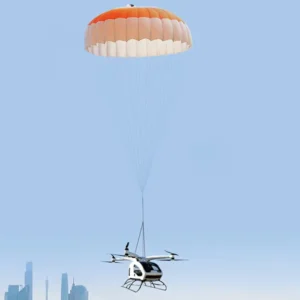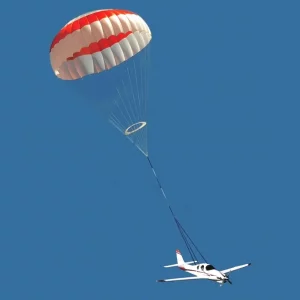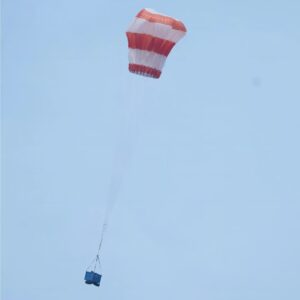The T191 Emergency Recovery Parachute System is specifically engineered to meet the safety demands of eVTOL, low-altitude multirotors, and other aerial platforms. Its design incorporates a mechanically activated rocket deployment system, ensuring rapid and reliable parachute deployment in critical emergency situations. The system is manually activated, providing the pilot with direct control to respond to power failures, flight malfunctions, or structural issues.
| Model | T191-800 |
| Maximum Deployment Weight | 800kg |
| Maximum Deployment Speed | 110km/h |
| Ejection System Component Weight | 2.5kg |
| Ejection System Dimensions | Φ79x355mm |
| Parachute Component Weight | 12.5kg |
| Packaging Method | Soft Pack |
| Container Dimensions | 40×14×34cm |
| Total System Weight | 15kg |
| Deployment Time (under Hovering Conditions) | 4s |
| Minimum Deployment Altitude (under Hovering Conditions) | 80m |
| Maximum Deployment Load | 6g |
| Maximum Descent Rate (at 1500 meters standard daytime temperature) | ≤7.5m/s (equivalent to a fall from a height of 2.9 meters) |
| Main Canopy Area | 175㎡ |
| Total Impulse | 700NS |
| Rocket Motor Burn Duration | 1±0.1 s |
| Rocket Activation Method | Manual Activation |
| Operating Temperature Range | – 40°C – +60°C |
| Maintenance Interval | 6Years |
| System Service Life | 12 Years |

The T193 Emergency Recovery Parachute System is tailored to fulfill the safety needs of eVTOLs, low-altitude multirotors, and similar aerial vehicles. This state-of-the-art system employs a gas-ejection mechanism for parachute deployment, providing rapid and dependable activation in critical situations. It offers multiple activation modes, including manual operation, flight control system-triggered deployment, and autonomous activation for enhanced operational flexibility.



Contact Us
Copyright © 2021. All rights reserved. Cookie Policy | Privacy Policy
WhatsApp us